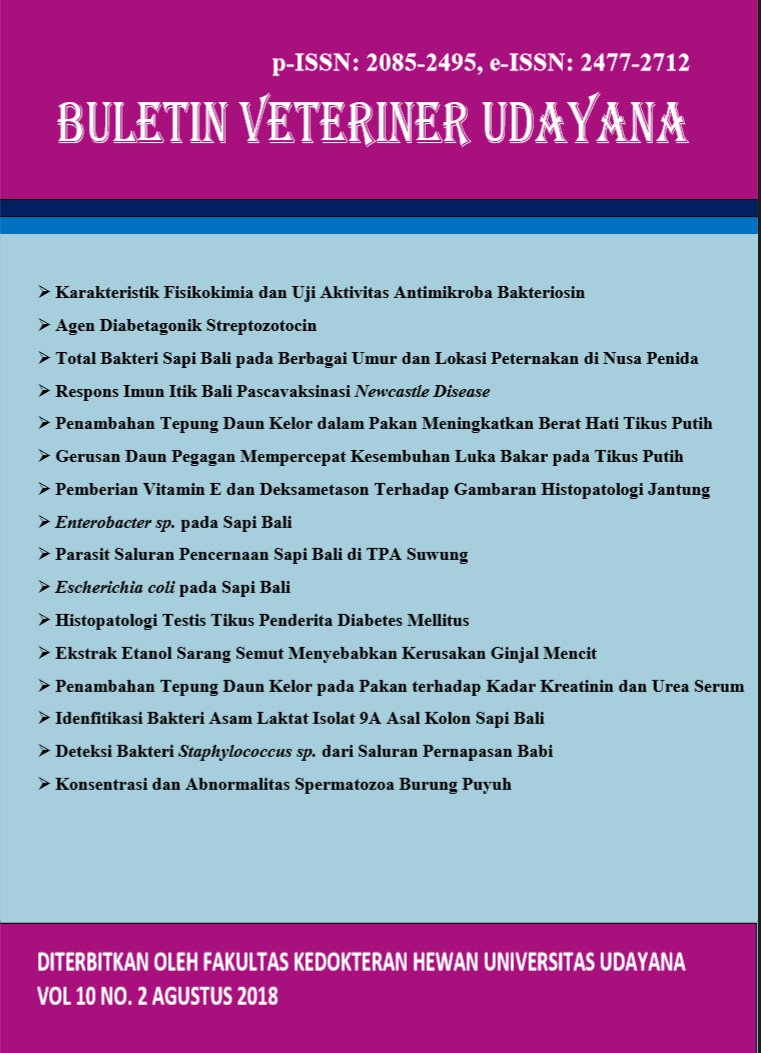PHYSICOCHEMICAL CHARACTERISTICS AND ANTIMICROBIAL ACTIVITY TEST OF BACTERIOCINS ORGINATED FROM LACTIC ACID BACTERIA ISOLATES 17B ISOLATED FROM BALI CATTLE COLON
Abstract
Lactic acid bacteria (LAB) is a microorganism that is not toxic and able to produce antimicrobial compounds, namely bacteriocins. This study aims to determine the physicochemical characterization of bacteriocins origin originated from lactic acid bacteria isolates 17B isolated from colon Bali cattle. The research was started by re-cultivation of isolates 17B and continued with production and precipitation of bacteriocins. Further tests were chemical and physical test that, followed by antimicrobial activity test of bacteriocin isolates 17B against Bacillus cereus FTCC 005. Data From this study are presented in tables or figure and analyzed descriptively. Results of study showed that LAB isolates 17B is a Gram-positive bacteria and catalase negative. The test also showed the bacteriocins produced isolates 17B as a protein compound indicated by the ninhydrin test positive, Molisch test negative and Lowry test positive with protein concentration was 0,11 µg/ml. Physical characterization tested using SDS PAGE showed that the test is negative. Antimicrobial activity test of bacteriocin isolates 17B showed that bacteriocin 17B has effectiveness against Bacillus cereus FTCC 005 as 18,92%.
Downloads
References
Janes ME, Nannapaneni R, Proctor A, Johnson MG. 1998. Rice Hull Ash and Silicic Acid Adsorbents for Concentration of Bacteriocins. Appl. Environ. Microbiol. 64(11): 4403-4409.
Korhonen J. 2010. Forestry and Naturals Sciences: Antibiotic Resistance of Lactid acid Bacteria, University of Eastern Finland.
Kusmiati, Malik A. 2002. Aktivitas Bakteriosin Dari Bakteri Leuconostoc Mesenteroides PBacL Pada Berbagai Media. Makara J. 16(1): 1-7.
Lindawati SA, Suardana IW. 2016. Isolasi dan Identifikasi Spesies Bakteri Asam Laktat Penghasil Senyawa Antimikrob Asal Kolon Sapi Bali. J. Vet. 17(4): 576-581.
Nigam A, Ayyagari A. 2007. Lab Manual in Biochemistry, Immunology, and Biotechnology. Tata MCGraw-Hill Publishing Company Limited: New Delhi.
Nuryady MM, Istiqomah T, Faizah R, Ufaidillah S, Mahmudi Z, dan Sutoyo. 2013. Isolasi dan Identifikasi Bakteri Asam Laktat Asal Yogurt. UNEJ. 1(5): 1-11.
Rasdiyanah. 2014. Karakteristik Protein dan Komposisi Asam Amino Otot Aktif dan Pasif pada Daging Sapi Bali dan Wagyu. Tesis. Pascasarjana Kedokteran Hewan Universitas Udayana. Bali.
Suardana IW, Suarsana IN, Sujaya IN, Wiryawan KG. 2007. Isolasi dan Identifikasi Bakteri Asam Laktat dari Cairan Rumen Sapi Bali sebagai Kandidat Biopreservatif. J. Vet. 8(4): 155-159.
Suardana IW, Suada IK, Sukada IM dan Suarsana IN. 2009. Isolasi dan Identifikasi Isolat Bakteri Asam Laktat SR9 Asal Cairan Rumen Sapi Bali sebagai Kandidat Unggul Probiotik. Medicina. J. Ilmiah Kedokteran. 40(2): 100-103.
Suardana IW. 2013. Potensi Isolat Lactobacillus brevis 1 Asal Cairan Rumen Sapi Bali sebagai Sumber Senyawa Antimikroba dalam Prosiding Seminar Nasional Sapi Bali “Peran Sapi Bali dalam Mewujudkan Swasembada Daging Nasional yang Berkelanjutan. Bali 24 September 2013. Pp: 87-97.
Suardana IW, Cahyani AP, Pinatih KJP. 2016. Probiotic Potency and Molecular Identification of Lactic Acid Bacteria Isolated from Bali Cattle’s Colon, Indonesia. Glo. Adv. J. Med. Med. Sci. 5(5): 143-149.
Suarsana IN. 2000. Isolasi dan Karakterisasi Substansi Antimikroba yang Dihasilkan oleh Bakteri yang Diisolasi dari Susu Sapi Mastitis. Tesis. Program Pasca Sarjana. IPB, Bogor.
Sudirman IF, Mathiau, Michael M, Lefebvre G. 1993. Detection and Properties of Curvaticin 13, a Bacteriocin Like Substance Produced by Lactobacillus curvatus SB 13. Cur. Microbiol. 27: 35-40.
Widyadnyana DGA, Sukrama IDM, Suardana IW. 2015. Identifikasi Bakteri Asam Laktat Isolat 9A dari Kolon Sapi Bali sebagai Probiotik melalui Analisis Gen 16S rRNA. J. Sain.Vet. 33(2): 228-233.





